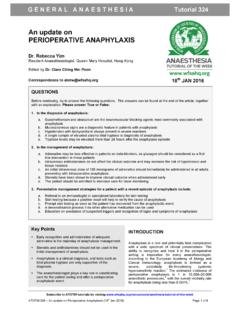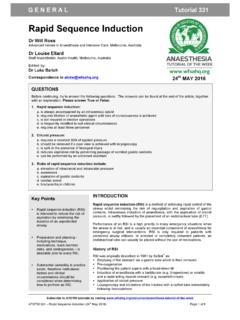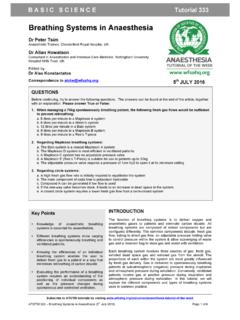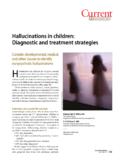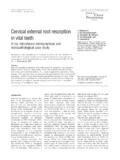Transcription of 341 Diagnosis and management of heat stroke
1 Subscribe to ATOTW tutorials by visiting ATOTW 341 Diagnosis and treatment of heat stroke (15th Nov 2016) Page 1 of 8 I N T E N S I V E C A R E Tutorial 341 Diagnosis and management of heat stroke Dr. Adam Burt Clinical Fellow, Intensive Care, Royal Cornwall Hospital NHS Trust, UK Edited by Dr. William English Consultant in Anaesthesia and Intensive Care Royal Cornwall Hospital NHS Trust, UK Correspondence to INTRODUCTION Despite heat stroke (HS) being originally described over 2000 years ago,1 the complex pathophysiological processes underlying heat illnesses, including heat stroke , are still not fully understood.
2 heat stroke is an important condition worldwide with a reported mortality rate of between 10-50%. In addition, 7-20% of survivors are left with persistent neurological ,3 Cardinal features of heat stroke are a core body temperature of >40 C and central nervous system dysfunction. This article will outline the different terms used to describe heat related illnesses. The risk factors, prevention, Diagnosis and treatment of this important group of illnesses will then be discussed. QUESTIONS Before continuing, try to answer the following questions.
3 The answers can be found at the end of the article, together with an explanation. Please answer True or False: heat dissipation and thermoregulation: human body dissipates heat via 4 mechanisms: evaporation, conduction, convection and radiation cooling can be facilitated by increasing the velocity of air flowing over the skin. the gradient of water pressure between skin and environment facilitates evaporative cooling. is the body s most effective form of heat loss control of thermoregulation lies within the medulla Diagnosis of heat stroke : temperature of >40 C is required to make a Diagnosis of heat stroke is a cardinal feature of heat stroke mental status is a cardinal feature of heat stroke athlete runs a half marathon on an unusually hot day.
4 After the race they suffer weakness, nausea, vomiting and collapse. This history is consistent with a Diagnosis of heat syncope. with heat stroke will almost always be tachycardic 3. Regarding risk factors and treatment of heat stroke : is an effective treatment for heat stroke are associated with heat stroke sex is protective against heat stroke is an effective treatment for heat stroke cooling should stop at C 15th Nov 2016 Key Points heat stroke has a mortality rate of between 10-50%. Cardinal features are core body temperature of > 40 C and central nervous system dysfunction.
5 Patients suffering from heat stroke may have a normal core temperature on arrival at hospital if effective pre-hospital cooling has occurred. Mainstays of treatment are rapid cooling and supportive care. Multiple organ support may be required. There are many different options for cooling. Choice should depend on local climate, availability and experience. Subscribe to ATOTW tutorials by visiting ATOTW 341 Diagnosis and treatment of heat stroke (15th Nov 2016) Page 2 of 8 heat RELATED ILLNESSES There are a number of different terms used to describe the various heat related illnesses.
6 It has been argued that many of these conditions are not separate entities but rather related conditions within a ,4-6 heat stroke is the most severe form of a number of illnesses caused by heat and the failure of normal homeostatic mechanisms. Classical or non-exertional HS (NEHS) refers to heat stroke resulting from high environmental temperature and humidity. Exertional HS (EHS) is secondary to excess heat production during strenuous ,3 Table 1. Definitions of heat related illnesses 4,5,7 Normal thermoregulation Humans are homeostatic organisms.
7 Optimal enzyme function requires body temperature to be maintained within a narrow range around 37 C. Body heat is gained from the environment and from cellular metabolism. Thermoregulation is controlled by the hypothalamus and the autonomic nervous system. Control is achieved via a number of physiological mechanisms. These include alterations of vascular tone (which result in changes in blood flow and blood distribution), shivering and ,4,5 heat dissipation occurs via 4 processes: evaporation, conduction, convection and ,5 The evaporation of sweat is the most effective method of heat loss; however, as the air temperature approaches body temperature, this mechanism becomes less effective.
8 Absence of sweating is more commonly seen in patients with NEHS in contrast to EHS, where sweating may be Conductive heat loss can be greatly increased by immersion in water cooler than body temperature. In addition to sweating, normal physiological responses to hyperthermia include increases in minute volume, heart rate and stroke volume. Cardiac output may increase 4 fold. Blood is shunted to the peripheries from the core. This may significantly reduce visceral perfusion, particularly intestinal and renal. Comorbidities or medications which reduce an individual s ability to shunt blood peripherally, will increase their susceptibility to HS (see below under Risk Factors).
9 2,4 Pathophysiology Current thinking is that HS is caused by thermoregulatory failure leading to hyperthermia and systemic inflammatory response syndrome (SIRS). This can result in multi-organ dysfunction, which was previously thought to be as a direct result of tissue injury caused by hyperthermia. Whilst tissue damage by direct thermal injury occurs at temperatures >46 C, metabolism and the inflammatory response is affected at lower temperatures (42-44 C).5,8 It now seems likely that the varied effects of HS are due to the combination of both direct thermal injury and SIRS.
10 The sequelae of HS have been noted to be similar to that of SIRS, involving a complex interplay between pyrogenic cytokines, interleukins, endothelial cells, endotoxins, TNF- and coagulation ,3,5,8 A genetic susceptibility to HS has also been suggested, with differences in the expression of genes that encode coagulation proteins, cytokines and heat shock proteins possibly accounting for why some individuals develop HS whilst others do not. A simplified schematic of the pathophysiology of HS is shown in figure 1. heat ILLNESS DEFINITION heat cramps Muscle cramping thought to be secondary to electrolyte deficiencies occurring during exercise heat syncope Fainting due to high ambient temperature causing peripheral vasodilation heat exhaustion Tiredness, weakness, headache, nausea and vomiting are frequent.
